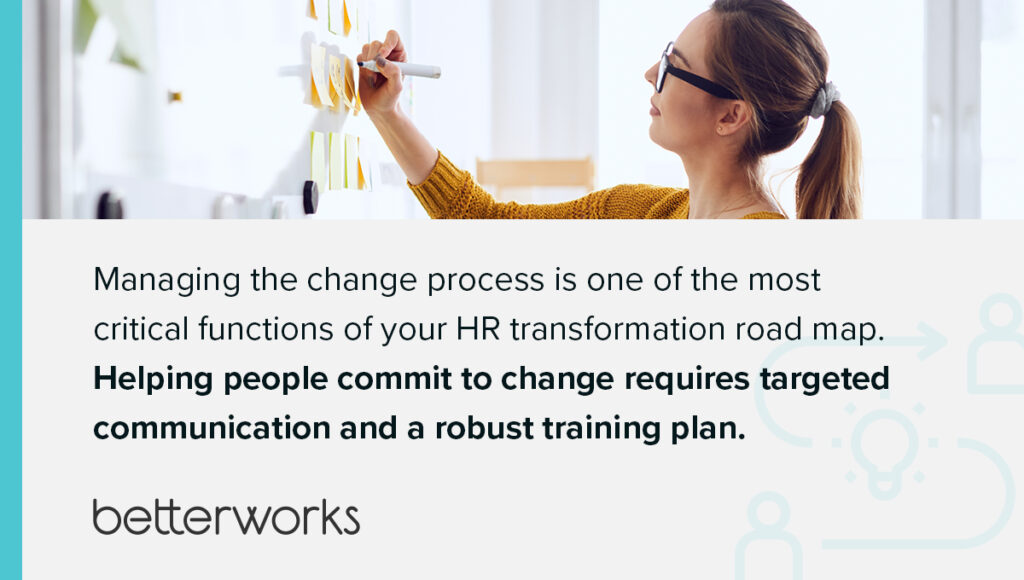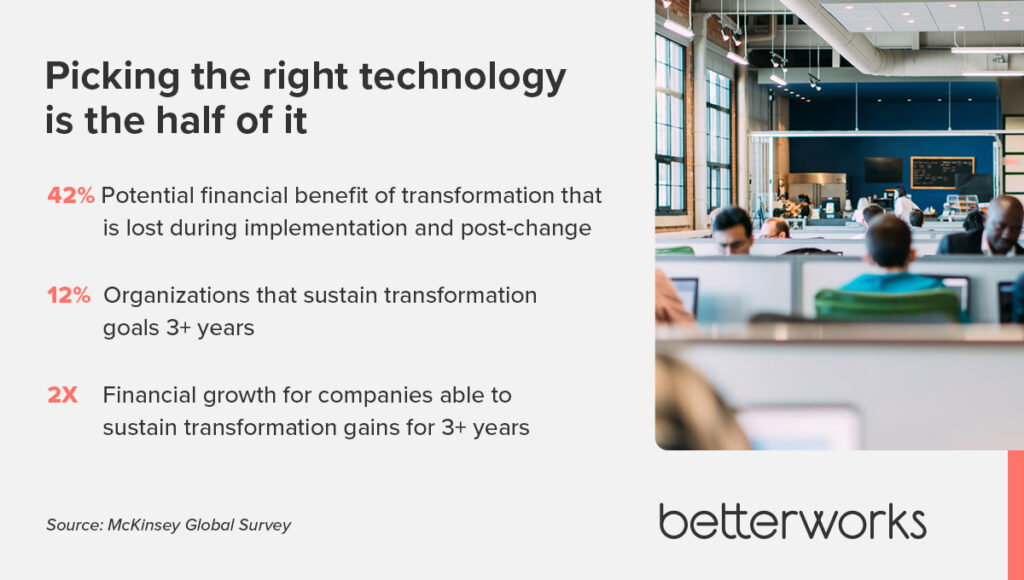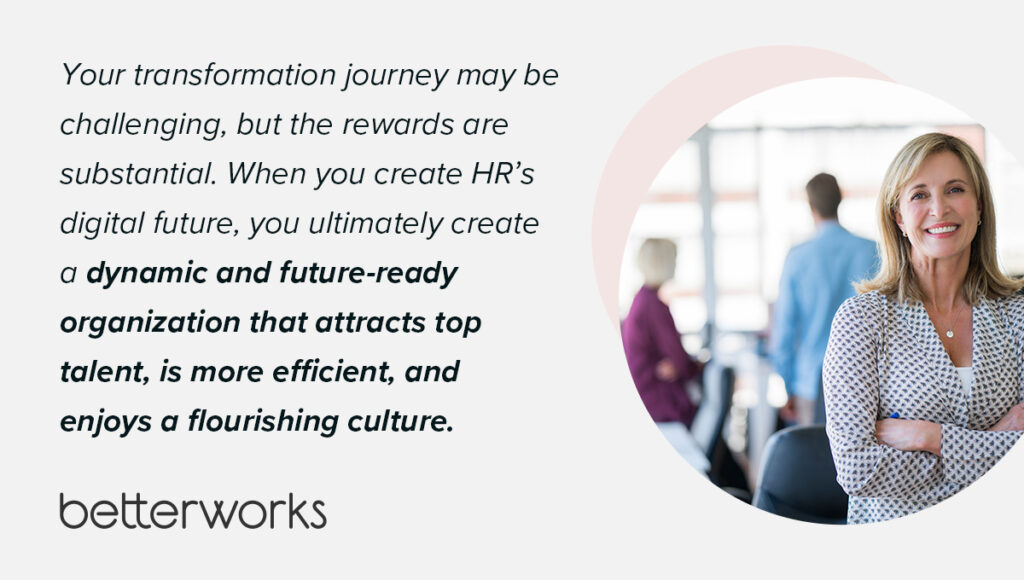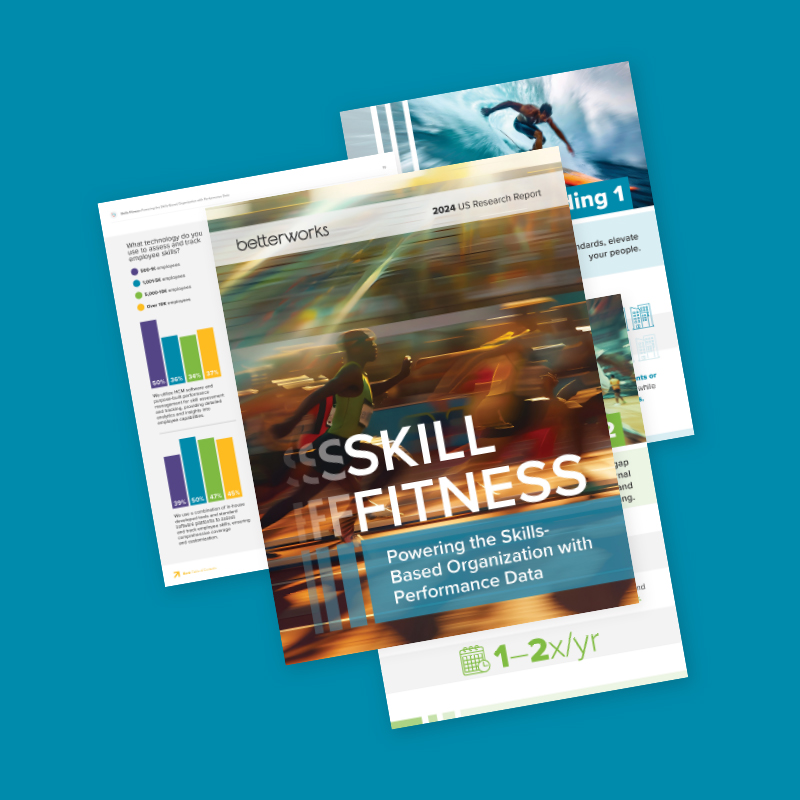Editor’s note: This is the sixth and final entry in a series on how to become a more strategic HR leader.
HR leaders around the world are undertaking an exciting journey — one that will see technology revolutionize talent strategy. You don’t need to walk this road alone. Everyone in your business is affected by HR decisions, so you want all of these stakeholders joining you on the path to transformative business practices, which often begin with reimagining people practices. Don’t get confused here. We’re not talking solely about transforming HR processes in a vacuum; most times the bigger business transformation requires a fundamental change in how we approach and reimagine HR.
The good news is that most people agree on the destination and that the road to business transformation typically starts with a solid digital strategy for your workforce. It’s no surprise that research from the Academy to Innovate HR found that nearly two-thirds of survey respondents “strongly agree” that digital is a key objective for their people strategy. And HR’s never been more ready for digital transformation — HR digital maturity has accelerated by at least seven years just since the pandemic began.
With HR’s increased digital maturity and more organizations investing in HR digital transformation, you can’t afford to fall behind.
To win buy-in for this transformation, it’s not enough to sell an ideal future state. You need to get key people to commit to a complex journey that could last three to five years. Read on for my advice on creating a road map that helps stakeholders embrace HR digital transformation.
Demonstrate your commitment to the change process
When it comes to managing change, a road map is as important for communication as it is for direction. Your HR transformation road map serves two purposes: Articulating the organization’s commitment and managing stakeholders’ expectations of when and how the transformation will take effect (and with minimal disruption).
Understandably, many people resist change because they fear its effects. Changing your performance management process, for instance, can put a lot of pressure on managers to learn new norms and expectations. A transformation road map assuages these fears because everyone can see the timeline and how you’ll support them along the way.
Remind people that you have a plan and that you’ll manage their expectations at each stage. Outline how many stages are needed to reach your destination and how long each one will take. Explain what’s going to happen in the first year and the following years.
Explain the benefits for each stakeholder involved with implementation and when they can expect a return on their investment. Managing expectations is crucial. You don’t want the business to take away your resources or shift your funding to other initiatives because they have an unrealistic timeline for results.
Create a change management plan
Managing the change process is one of the most critical functions of your HR transformation road map. Helping people commit to change requires targeted communication and a robust training plan.
Major changes need strong branding to elevate their impact, says my colleague Rob Budzinski, Betterworks vice president of professional services. A basic communication plan is a straightforward and simple way of sharing information via select channels. A branded communication plan, by contrast, uses marketing concepts to make communication more appealing and memorable. You’ll brand the change initiative with a distinct identity for each stakeholder group.
Branding and targeted communication make all the difference in how people respond to complex changes in their environment. You need the right level of communication, messaging that’s tailored to the recipient’s interests and needs, and ambassadors who will vouch for the change initiative.

Likewise, people require different levels of training depending on their involvement in the transformation. If you’re embracing performance enablement in the flow of work, for example, success rests on the managers who carry out this plan. If they aren’t trained on giving feedback effectively during regular conversations with employees, your change effort will struggle.
The bottom line is making sure that everyone understands what the program is, why it’s being done, and what their role is.
Your training materials will vary, too, depending on how each stakeholder or group best absorbs or accesses information. Some people prefer on-demand learning, for instance, while others do best with interactive instruction.
Invest in governance
Long-term governance needs to be on your HR transformation road map because it provides a framework for accountability, decision-making, resource allocation, prioritization, and implementing changes. These are essential to making progress and adapting to changing circumstances required for continuous improvement.
According to a McKinsey Global Survey, 56 percent of respondents say their organizations have achieved most or all of their transformation goals, but only 12 percent report that they have sustained these goals for more than three years. What’s more, 42% of the potential financial benefit from organizational transformations is lost during execution of the large-scale change effort and post-transformation.
The good news? If your implementation succeeds, the payoff is big. McKinsey’s research shows that organizations that accomplished their performance goals and sustained the gains from transformation for more than three years have twice the rate of financial growth as their peers.

Governance starts as simply monitoring your plan, holding regular check-ins with key stakeholders, and adjusting the change effort as necessary. More broadly, good governance has three levels.
Strategic
At this highest level, engage regularly with stakeholders to ensure that the transformation plan is aligned with what the business needs. Decisions that happen at this level include scaling back the change initiative or changing directions.
Functional
This next level focuses on process ownership. Consider these types of questions:
- Are stakeholders adopting the change plan? Are we seeing their behaviors change?
- If not, what do we need to do to enable that to happen? Do we need to put more resources into it? Do we need to slow down?
- Do we need to offer more support to stakeholders who are struggling to adapt? What does that support look like?
Answering these questions helps gauge where you are on your transformation road map. If you find yourself off-course, you at least have the awareness and can try to get back on track.
Technology
Technology powers your HR strategy. At this level, consider whether you’re keeping up with vendor updates and broader technology changes. Are your tech and processes current? Be careful about overemphasizing this level: I’ve noticed that people tend to get stuck on the tech part of HR transformation at the expense of the strategic and functional levels.

Benefits of governance
Good governance enables focus, speed, quality, and innovation.
Focus: Create positive accountability conditions with clear expectations and outcomes, and enable management, tracking, and measurement of processes, projects, and budget decisions.
Speed: Address out-of-scope decisions and mitigate risks quickly. Gain timely support from key stakeholders.
Quality: Sync human resources and organizational goals and outcomes. Promote cross-functional collaboration throughout decision-making.
Innovation: Create conditions for the exchange of ideas, information, and decisions. Increase transparency and collaborations, and empower a network of change agents.
Your transformation journey may be challenging, but the rewards are substantial. When you create HR’s digital future, you ultimately create a dynamic and future-ready organization that attracts top talent, is more efficient, and enjoys a flourishing culture.
As VP of HR Transformation at Betterworks, Jamie helps customers reimagine the way employee performance is managed with proven systems and processes that work. She is co-author of the book, Make Work Better, and draws inspiration from her more than twenty-five years of HR leadership experience, spearheading organizational development, HR transformation, and employee engagement strategies that boost business performance.
Master strategic HR leadership






